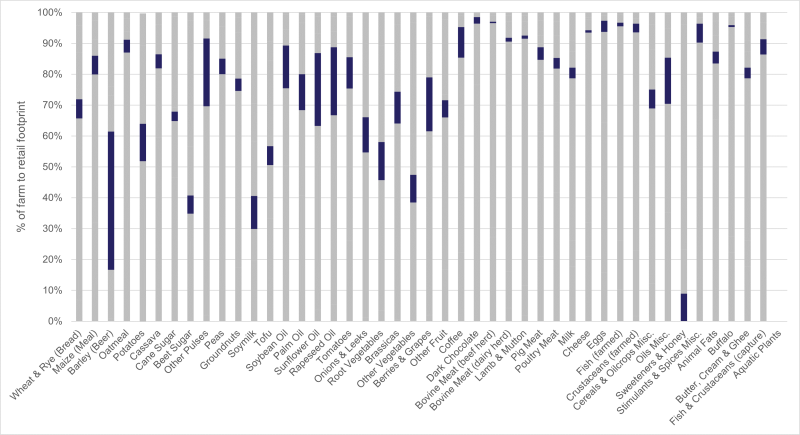7.1.3
Packaging
Packaging remains one of the most high-profile environmental topics for many retail customers,[101] with concerns related to perceptions of excess material use, poor recyclability, single use plastics and marine pollution from ‘ocean plastics’.
Emissions profile
The significance of greenhouse gas emission from packaging materials varies by retail sector, representing as much as 25% for food on the go, or as little as 2-3% for electrical goods. See Figure 7.1f for example carbon footprints of packaging in different food and drink products – highlighted in red.

Figure 7.1f: Contribution of packaging to a selection of food and beverage product footprints[102]
Routes to decarbonisation for packaging
Reducing emissions from packaging can be achieved through adopting as many of the following interventions as possible when designing and specifying product packaging:
- Use of refill and ‘naked’ packaging solutions for appropriate products – for example in 13 product categories highlighted by research by Greenpeace[103]
- Reduction in material weight
- Working in collaboration with product and with packaging suppliers to source materials from low carbon processes (e.g. powered by renewable energy)
- Substitution of materials to lower carbon alternatives
- Increase proportion of recycled content used (note that from 2022 taxes will apply for plastic packaging that does not contain at least 30% recycled content)[104]
- Increase end of life recyclability
There is interplay between these parameters, and the optimal approach for different products will depend on performance requirements, production lines, etc. Also, it is critical that changes to packaging do not result in more product waste, damage, or returns – particularly in food products.
[101] For example, AHDB (2019) Consumer views on plastic and the environment
[102] Poore, J. and Nemecek, T. (2018) Reducing food’s environmental impacts through producers and consumers. Science 01 Jun 987-992
[103] Greenpeace (2020) Unpacked: how supermarkets can cut plastic packaging in half by 2025
[104] Plastic packaging tax (2020). HM Revenue and Customs.